Thermoses with glass flask

A thermos is an indispensable tool for travel and picnics. You can’t do without it for those who, due to their service or profession, cannot eat hot food in catering places. In addition, it is convenient to brew and infuse herbal preparations in a thermos, give the student drinks for study or training. One of the most popular options is a product with a glass flask. About it and will be discussed further.
Advantages and disadvantages
The main advantage of thermoses with a glass flask is their absolute tightness. This is due to the production technology, thanks to which it is possible to avoid the appearance of a seam on the product.

Glass is a more hygienic material than metal. It does not change the taste of dishes, does not retain odors. Remains of food and greasy stains are easily removed from the glass surface. Due to its hygiene, a thermos with a glass flask is the best option for storing baby food or drinks. And thanks to the fact that plaque from coffee or tea is easily removed from glass surfaces; such products are successful for preserving coffee, tea, herbal preparations.

The disadvantage of glass products is their fragility. Although it is fair to say that today tempered glass is used for the manufacture of flasks, which is very difficult to break.We can say that this shortcoming is partially leveled.

A disadvantage can also be considered an increased (compared to a metal counterpart) risk of damage to the flask during temperature changes. However, most thermoses with glass flasks imply the possibility of replacing them.
Comparison with a metal flask
The main difference between a glass bulb and a metal one (in addition to the type of material, of course) is the production technology. If the latter in any case has a seam, then the glass version is only a tightly sealed nipple. Even with the highest quality of welding, sooner or later, microdamages appear on the seam in metal flasks, leading to a violation of the tightness of the product. This does not happen with glass models, which theoretically can mean an infinitely long operation of such a thermos.
When comparing materials, glass is more hygienic and easier to clean. In a thermos with a glass flask, food does not oxidize, it is easy to remove it from the surface. But to clean the metal counterpart, sometimes it is necessary to resort to soaking in an acid-alkaline environment, which, in turn, leads to material deterioration.
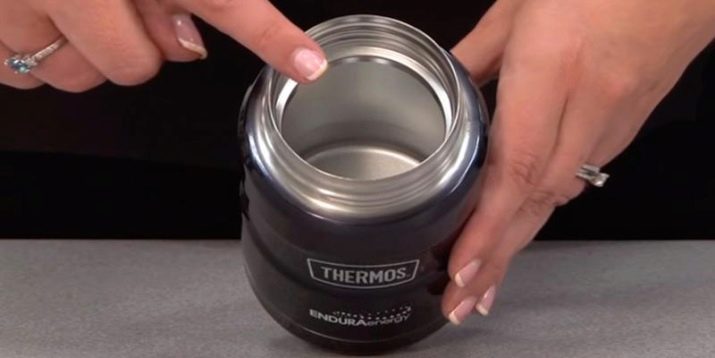
The glass bulb must be replaced, unlike the metal one. However, the latter is also more durable - it is not afraid of shocks, temperature changes.

Volumes and design
Thermoses are for food and drinks. The design and volume of the product depends on this. If you have a thermos with a wide neck, the volume of which is usually 1 liter or less, you can store first and second courses in it. Larger vessels with a narrow neck are designed for drinks. However, the latter may have a different volume.


If you are looking for a product that will keep heat as long as possible, it makes sense to purchase a double-walled thermos. A vacuum is created between them, which reduces heat loss. The mirror inner layer serves the same purpose (to keep the temperature as long as possible). There are thermoses with silver-coated flasks, as well as mirror analogues. The second one is definitely better.
The volume of the thermos ranges from 250 ml to 5 or more liters. For most tourists and hikers, a thermos with a volume of 750 ml or 1 liter is sufficient. This stock is enough for 1-2 people.

For camping or a longer trip, a 2-liter vessel will be optimal. The volume of a family thermos usually starts from 2.5-3 liters. For a short walk around the city, a thermal bottle or a thermo glass is enough, their volume is 250–500 ml.
The outer case of the product is usually metal or plastic. The former, as a rule, have a natural metallic tint, look stylish and concise. Plastic models are painted in various colors. Today, tin models painted under Khokhloma are also returning to fashion.

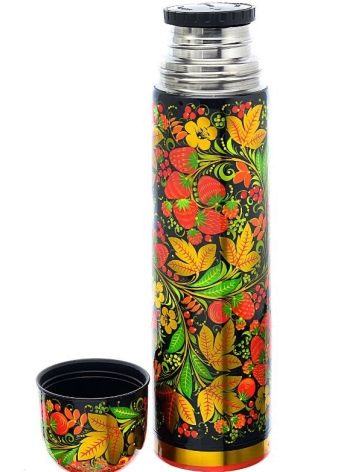
Manufacturers overview
Today, the rating for the production of thermoses with a glass flask is headed by China. Moreover, such a “title” was received by the country not just because of the total number of products produced, but because of its highest quality. It is Chinese products that are currently considered the best.
German manufacturer may compete with Chinese brands EMSA, as well as some companies in Brazil (Termolar, TM Invista), India. It is noteworthy that almost all glass flasks are produced in these countries. They come to Russia from China, although the product can be assembled anywhere. The label often indicates the final assembly point.


Such a small geography of production is associated with the difficulties of manufacturing glass flasks. In this regard, release stainless steel counterparts are simpler and cheaper. Despite the fact that today glass flasks are not blown (it is incredibly expensive), but produced on special equipment, its purchase and maintenance require a lot of financial effort.
In addition, the production plant must have the most powerful cleaning systems, since the process of applying a reflective silver coating in itself causes damage to the environment.
These reasons are the main ones, it is in connection with this that today up to 85% of flasks are produced exclusively by China. Until recently, there were 2 plants producing Russian-made products - the PJSC Svetlana plant (Novgorod region) and the Fryazinsky plant. The first closed, the second continues to produce Khokhloma-style tin products, but the flasks for them have been supplied from China for 10 years.

Consider the most popular brands that inspire confidence in customers.
Mimi
Models from a Chinese manufacturer, the most common in the domestic market. Designed for drinks, as well as the first / second course. Depending on the purpose, they are equipped with one or two bowls. The model range includes products with a volume of 0.22 to 3.2 liters. Differences in products also relate to the characteristics of the neck - there are thermoses with both a wider (for food) and narrower (for broths and drinks) neck. Vessels of large volume with a narrow neck retain heat best of all.


The flask for a thermos is made of soda silicate tempered glass, the body is made of plastic. The latter is painted in pleasant gentle colors.Due to the fact that in the area of the bottom and neck the flask is protected by silicate inserts, falling from a meter height for a thermos in most cases is not terrible.
In general, the brand's products are characterized by convenience and practicality. Thermoses are ergonomic, lightweight, and a broken flask can be replaced with a new one, after which the operation of the product can be continued.
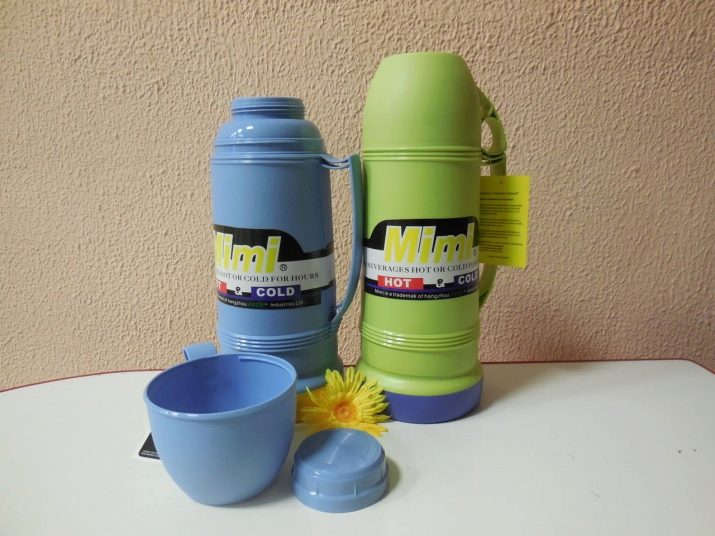
Thermos
Products of German-Chinese production. The trade name belongs to a German company, while the assembly of products is carried out in China. Thermoses have several varieties - classic containers for drinks, pump models and thermoses-jugs. The volume of products ranges from 0.5 to 2.2 liters.

The glass bulbs in such products are known for being able to easily withstand both the temperature of ice water and boiling liquid. This is made possible by a patented flask manufacturing method. The temperature of drinks is kept up to 12 hours.
The body of the product is plastic, in the area of the neck and bottom there is a cushioning made of silicone, which reduces the likelihood of breakage of the flask.
The lid is equipped with a special valve, which, when open, helps to conveniently pour the drink without spilling it, when closed - eliminates the risk of leakage.


For convenience, the thermos has a rubberized handle (it is comfortable to hold, does not slip out of your hands), and the lid can be used as a cup.
Some users say that washing this thermos is not very convenient - it requires complete disassembly. Otherwise, water flows into separate compartments and remains there.
Exco
Another Chinese manufacturer that produces thermoses of 2 types - for food (have a wide neck) and for drinks (narrow neck).Containers of the first type are subject to large heat losses, so the food retains the temperature for only 6-8 hours.
A fairly inexpensive, easy-to-use model with a glass flask enclosed in impact-resistant plastic. The design assumes the presence of a seal in the bottom area and a silicone ring in place of the neck.

The maximum temperature of the liquid that can be poured into a thermos is 50–55 C. Food models are equipped with compartments for salt / spices and bread, which is very convenient.
The thermos is lightweight, the lid can be used as a cup, and if the flask is broken, it can be replaced with a new one.
EMSA
Products entirely manufactured in Europe (Germany). Under this brand, containers for drinks and food, children's models, as well as thermos pumps are produced. The volume of the product is 0.5-1.4 liters. According to the manufacturers, products keep cold up to 24 hours, warm - up to 12 hours.

Each type of thermos has visible advantages. So, containers for drinks have a special valve. It is enough to open it so that you can pour the liquid. There is no need to remove the entire cover, which will lead to heat loss.
Thermoses-jugs are equipped with a spout, and food models are equipped with containers for heating food in the microwave or just a convenient meal. Another clear advantage is the ability to wash the product in the "dishwasher".

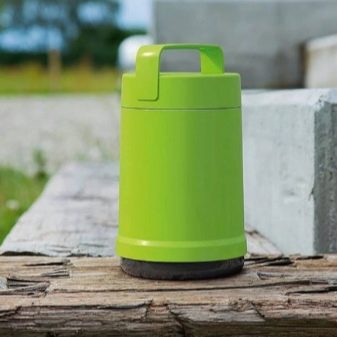
Delta
The products of this Chinese manufacturer will be appreciated primarily by lovers of Soviet thermoses. Models have a tin case painted under Khokhloma. The flask is made of tempered glass with a thermal reflective coating on both sides.
The product has a narrow neck, the lid can be used as a bowl, and the thermos is also equipped with a handle that makes it easy to carry.But for pouring a drink, such a handle will be inconvenient, since it is attached not from the side, but from above. The metal lid of the thermos can hardly be used as a cup - it heats up quickly.

LaPlaya
The brand belongs to a German holding, the assembly of products is carried out in China. The model range is represented mainly by containers for drinks. Volume - from 0.5 to 2 liters.
Products are characterized by low weight, have a rubberized handle. The lid can be used as a cup, and there is also a separate compartment for storing tea bags, sugar.
To pour a drink, you can not unscrew the lid, but only open a small compartment. This will avoid heat loss. Besides, The thermos is equipped with a spout, thanks to which it is possible to pour the liquid without spilling it.

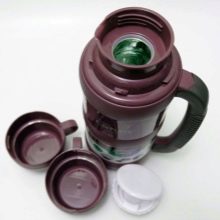
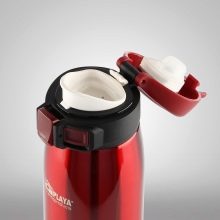
Despite the numerous advantages, on the network you can find reviews of dissatisfied users. Their main claim to the manufacturer is the fragility of the flask during temperature changes.
Zojirushi
Respected Japanese brand. Japan is different because produces thermoses mainly for food. Convenient design, compartments for spices and bread, high rates of heat retention - this is what helped the manufacturer to earn consumer love.

How to choose?
The first thing to check before buying a thermos is its solidity. The flask should be located in the body tightly, by surprise. If she hangs out, the purchase should be abandoned. In no case should the product have foreign odors. Sometimes sellers assure that it will disappear, disappear. However, the opposite can also happen - when pouring hot, the smell will intensify. It's not worth the risk.

Pay attention to the lid she should not bend and "play". The lid should close strictly along the thread, without distortions and gaps, while you should not put much effort into screwing. It would be useful to check if the bottom can be unscrewed. This may be required to replace the bulb.
Be sure to look into the product data sheet. An indicator of quality will be the ability of the thermos to withstand the temperature of liquid and food at least 50-60 C and hold the temperature for at least 12-24 hours.


At home, you can conduct a test - pour hot water into a thermos and leave for 2-3 hours. After this time, the case may become slightly warm, but in no case should it become hot. This indicates that the product does not hold heat well.
How to care?
A glass flask does not tolerate sudden temperature changes, so you should not pour hot liquid into a vessel brought from frost. It is also better not to pour boiling water and boiling soups, broths immediately, but letting them cool to 50-60 C. Do not actively shake the thermos with a glass flask and stir sugar in it with a metal spoon.
Do not use abrasives for cleaning. If an unpleasant odor appears, the thermos can be washed with a weak vinegar solution. Remove the product for storage only after thorough drying.
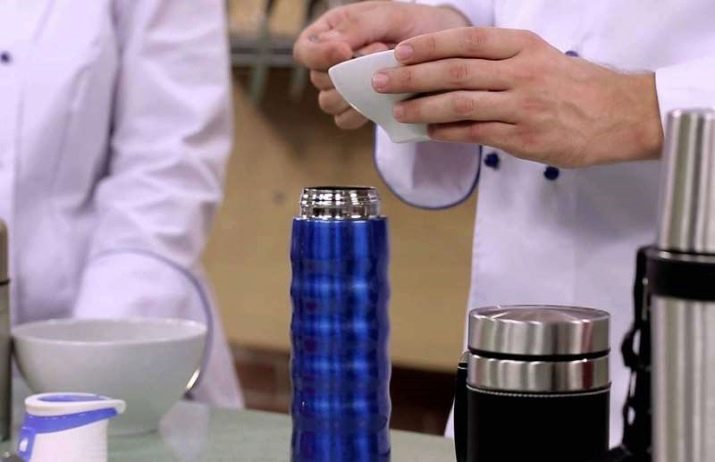
The thermos can only be washed in the dishwasher if it is approved by the manufacturer.
An overview of the Chinese thermos with a glass flask, see the following video.




























